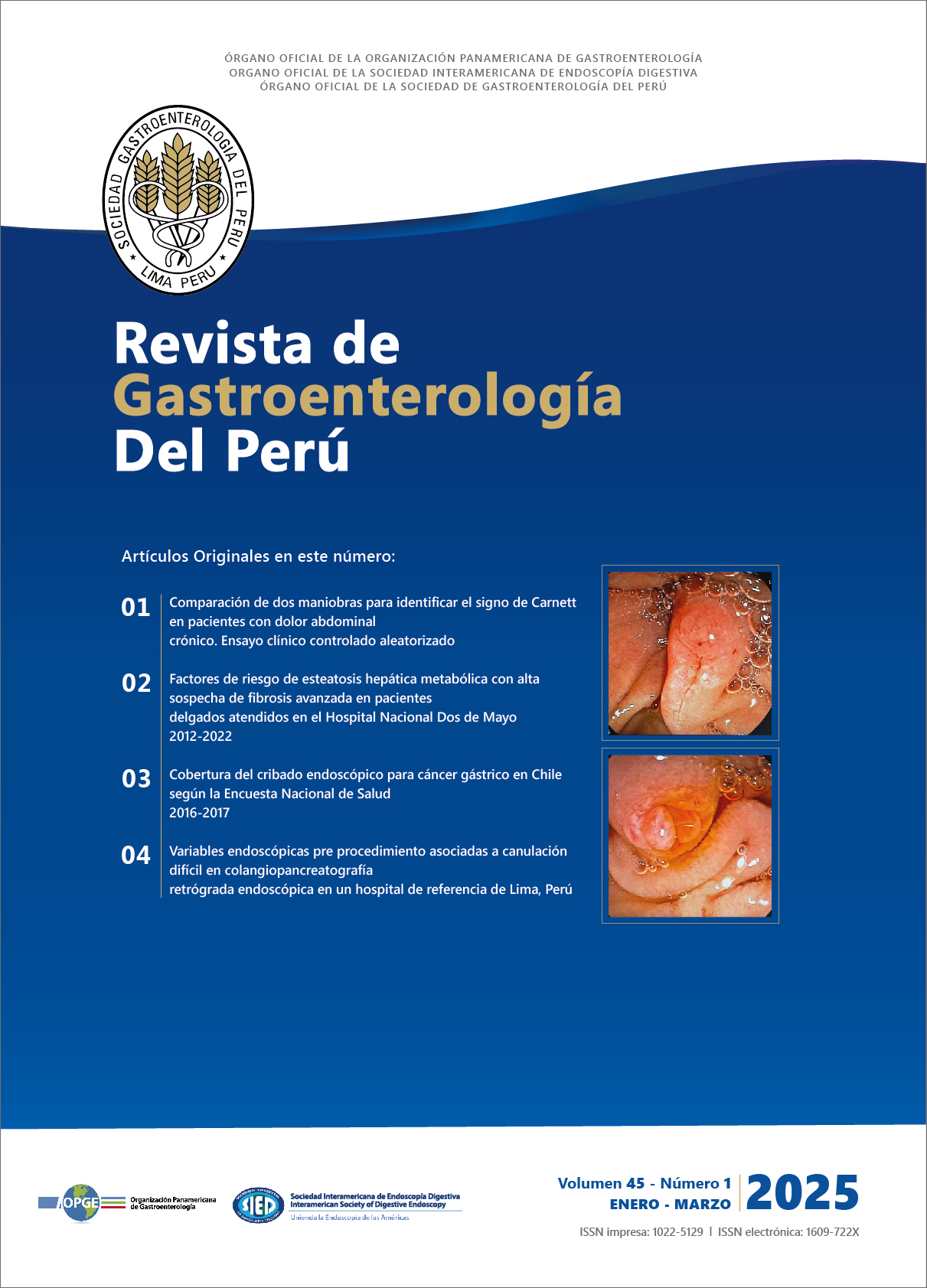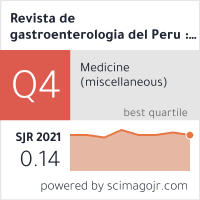Endoscopic features of drug-induced esophageal ulcer: “the kissing ulcer”
DOI:
https://doi.org/10.47892/rgp.2025.451.1866Palabras clave:
Doxycycline, Dysphagia, Esophagitis, EsophagogastroduodenoscopyResumen
Resumen
Drug-induced esophageal ulcers constitute an acquired chemical injury to the esophageal mucosa, most frequently associated with tetracyclines, particularly doxycycline. We report a case of "kissing ulcers" diagnosed through esophagogastroduodenoscopy in a young woman undergoing doxycycline treatment for rosacea. The pathogenesis is linked to drug-specific factors, such as caustic effects, hyperosmolar properties, and prolonged mucosal contact with the medication, in addition to patient-specific risks, including esophageal motility disorders, reduced saliva production, and mid-esophageal anatomical compression. Clinically, patients commonly present with abrupt-onset chest pain, dysphagia, and odynophagia, while endoscopic findings often reveal mucosal erythema, erosions, and specular distribution esophageal ulcers (referred to as “kissing ulcers”). Management involves discontinuation of the causative drug, initiation of proton pump inhibitors or sucralfate, and implementation of preventive measures, such as ensuring adequate hydration during medication intake. This condition is generally self-limiting, with symptoms resolving within two weeks, underscoring the importance of prompt diagnosis and treatment to avoid potential complications.
Descargas
Métricas
Citas
Zografos GN, Georgiadou D, Thomas D, Kaltsas G, Digalakis M. Drug-induced esophagitis. Dis Esophagus. 2009;22(8):633-7. doi: 10.1111/j.1442-2050.2009.00972.x.
Jaspersen D. Drug-induced oesophageal disorders: pathogenesis, incidence, prevention and management. Drug Saf. 2000;22(3):237-49. doi: 10.2165/00002018-200022030-00007.
Kim SH, Jeong JB, Kim JW, Koh S-J, Kim BG, Lee KL, et al. Clinical and endoscopic characteristics of drug-induced esophagitis. World J Gastroenterol. 2014;20(31):10994-9. doi: 10.3748/ wjg.v20.i31.10994.
Hu SW, Chen AC, Wu SF. Drug-Induced Esophageal Ulcer in Adolescent Population: Experience at a Single Medical Center in Central Taiwan. Medicina (Kaunas). 2021;57(12):1286. doi: 10.3390/medicina57121286.
Habeshian KA, Cohen BA. Current Issues in the Treatment of Acne Vulgaris. Pediatrics. 2020;145(Suppl 2):S225-S230. doi: 10.1542/peds.2019-2056L.
Boyce HW Jr. Drug-induced esophageal damage: diseases of medical progress. Gastrointest Endosc. 1998;47(6):547-50. doi: 10.1016/s0016-5107(98)70264-0.
O’Donnell C, Tandon P, Govardhanam V, Habal F. Pill-induced esophagitis from intake of dietary supplements. ACG Case Rep J. 2019;6(6):e00106. doi: 10.14309/crj.0000000000000106.
Kadayifci A, Gulsen MT, Koruk M, Savas MC. Doxycycline-induced pill esophagitis. Dis Esophagus. 2004;17(2):168-71. doi: 10.1111/j.1442-2050.2004.00384.x.
Dag MS, Abidin Ozturk Z, Akin I, Tutar E, Cikmam O, Taner Gulsen M. Drug-induced esophageal ulcers: Case series and the review of the literature. Turk J Gastroenterol. 2014;25(2):180-4. doi: 10.5152/tjg.2014.5415.
Hey H, Jørgensen F, Sørensen K, Hasselbalch H, Wamberg T. Oesophageal transit of six commonly used tablets and capsules. Br Med J (Clin Res Ed). 1982;285(6356):1717-9. doi: 10.1136/bmj.285.6356.1717.
Yamaoka K, Takenawa H, Tajiri K, Yamane M, Kadowaki K, Marumo F, et al. A case of esophageal perforation due to a pillinduced ulcer successfully treated with conservative measures. Am J Gastroenterol. 1996;91(5):1044-5.
Kikendall JW, Friedman AC, Oyewole MA, Fleischer D, Johnson LF. Pill-induced esophageal injury: Case reports and review of the medical literature. Dig Dis Sci. 1983;28(2):174-82. doi: 10.1007/BF01315148.
Abid S, Mumtaz K, Jafri W, Hamid S, Abbas Z, Shah HA, et al. Pill-induced esophageal injury: Endoscopic features and clinical outcomes. Endoscopy. 2005;37(8):740-4. doi: 10.1055/s2005-870129.
Bonavina L, Demeester TF, Mcchesney L, Schwizer W, Albertucci M, Bailey RT. Drug-induced esophageal strictures. Ann Surg. 1987;206(2):173-83. doi: 10.1097/00000658-198708000-00010.
Mueller S, Aigner T, Neureiter D, Stolte M. Eosinophil infiltration and degranulation in oesophageal mucosa from adult patients with eosinophilic oesophagitis: a retrospective and comparative study on pathological biopsy. J Clin Pathol. 2006;59(11):1175-80. doi: 10.1136/jcp.2005.031922.
Descargas
Publicado
Cómo citar
Número
Sección
Licencia
Derechos de autor 2025 Felipe Silva, Gonzalo Latorre, Alberto Espino

Esta obra está bajo una licencia internacional Creative Commons Atribución 4.0.
Revista de Gastroenterología del Perú by Sociedad Peruana de Gastroenterología del Perú is licensed under a Licencia Creative Commons Atribución 4.0 Internacional..
Aquellos autores/as que tengan publicaciones con esta revista, aceptan los términos siguientes:
- Los autores/as conservarán sus derechos de autor y garantizarán a la revista el derecho de primera publicación de su obra, el cuál estará simultáneamente sujeto a la Licencia de reconocimiento de Creative Commons que permite a terceros compartir la obra siempre que se indique su autor y su primera publicación esta revista.
- Los autores/as podrán adoptar otros acuerdos de licencia no exclusiva de distribución de la versión de la obra publicada (p. ej.: depositarla en un archivo telemático institucional o publicarla en un volumen monográfico) siempre que se indique la publicación inicial en esta revista.
- Se permite y recomienda a los autores/as difundir su obra a través de Internet (p. ej.: en archivos telemáticos institucionales o en su página web) antes y durante el proceso de envío, lo cual puede producir intercambios interesantes y aumentar las citas de la obra publicada. (Véase El efecto del acceso abierto).

















 2022
2022 